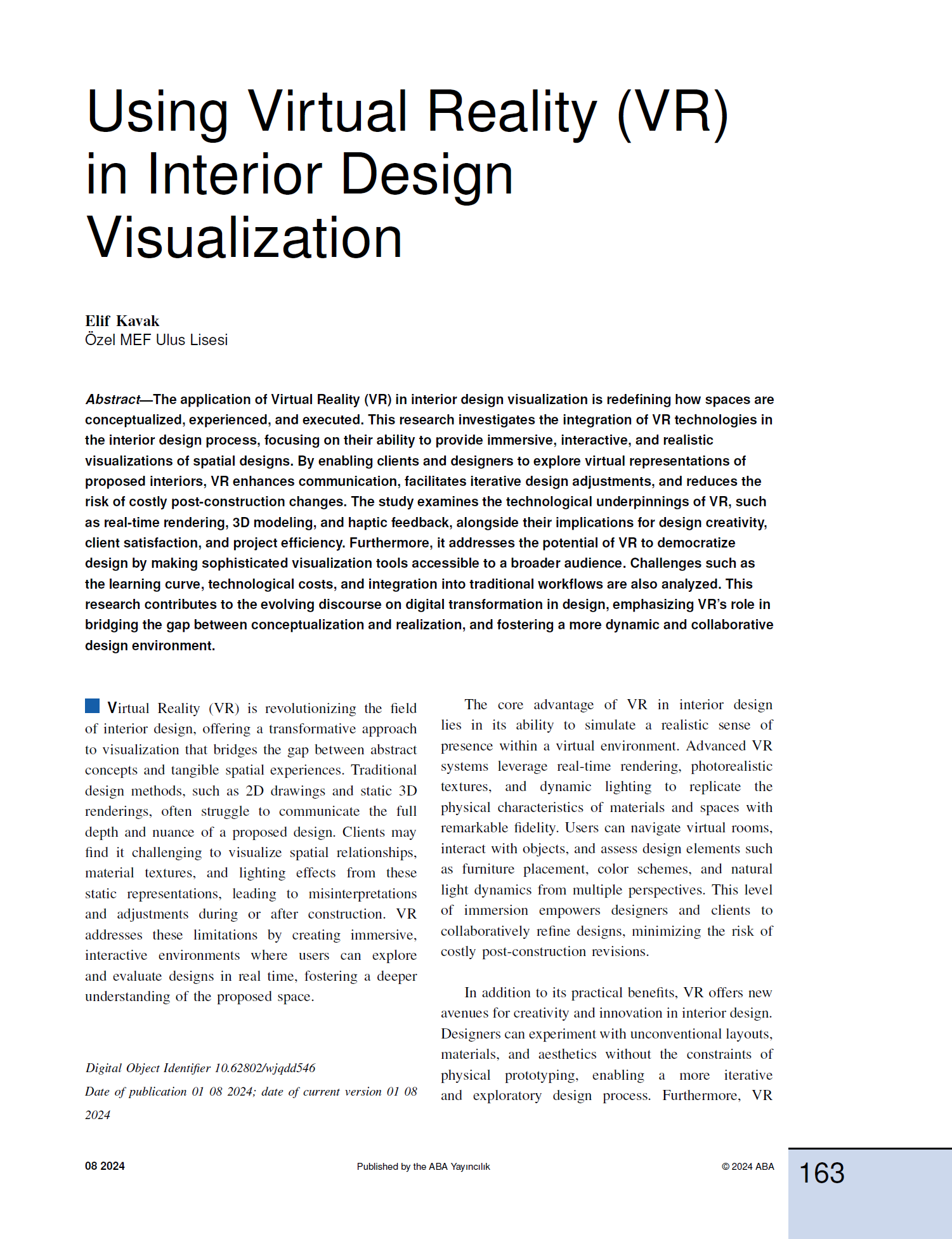Using Virtual Reality (VR) in Interior Design Visualization
DOI:
https://doi.org/10.62802/ex60p006Keywords:
Virtual Reality, Interior Design, Design Visualization, Immersive Technology, 3D Modeling, Real-Time Rendering, Client Interaction, Design Innovation, Digital Transformation, Architectural VisualizationAbstract
The application of Virtual Reality (VR) in interior design visualization is redefining how spaces are conceptualized, experienced, and executed. This research investigates the integration of VR technologies in the interior design process, focusing on their ability to provide immersive, interactive, and realistic visualizations of spatial designs. By enabling clients and designers to explore virtual representations of proposed interiors, VR enhances communication, facilitates iterative design adjustments, and reduces the risk of costly post-construction changes. The study examines the technological underpinnings of VR, such as real-time rendering, 3D modeling, and haptic feedback, alongside their implications for design creativity, client satisfaction, and project efficiency. Furthermore, it addresses the potential of VR to democratize design by making sophisticated visualization tools accessible to a broader audience. Challenges such as the learning curve, technological costs, and integration into traditional workflows are also analyzed. This research contributes to the evolving discourse on digital transformation in design, emphasizing VR's role in bridging the gap between conceptualization and realization, and fostering a more dynamic and collaborative design environment.References
Hareri, A. P. D. R. H., & Mohammad, R. W. A. K. Evaluating customer experience of using virtual reality technology for interior design projects: Case study of projects for an interior design agency in Medina.
Joy, E., & Raja, C. (2024). Digital 3D modeling for preconstruction real-time visualization of home interior design through virtual reality. Construction Innovation, 24(2), 643-653.
Lei, L. (2024, March). An interior design framework utilizing image processing and virtual reality technologies. In Second International Conference on Physics, Photonics, and Optical Engineering (ICPPOE 2023) (Vol. 13075, pp. 507-514). SPIE.
Qian, B., & Sutunyarak, C. (2024). Factors Affecting Virtual Reality Interior Design Products Acceptance Behavior of Consumer from Shenzhen City, China. Journal of Electrical Systems, 20(6s), 853-879.
Stoykov, D. (2024, May). Colour Perception in Camper Van Interior Design Using Virtual Reality Technology. In Proceedings of the Bulgarian Academy of Sciences (Vol. 77, No. 5, pp. 735-744).
Vo, H. (2024, July). Teaching Design with Consumer-ready Artificial Intelligence and Virtual Reality: A Case Study. In ACM SIGGRAPH 2024 Educator's Forum (pp. 1-2).
Wu, P., Liu, Y., Chen, H., Li, X., & Wang, H. (2025). VR-empowered interior design: Enhancing efficiency and quality through immersive experiences. Displays, 86, 102887.
Xia, F., Luo, Q., Su, F., Li, Z., Han, L., Zhao, X., & Zhang, X. (2024, October). Application and effect evaluation of virtual reality in interior design. In Fifth International Conference on Computer Vision and Data Mining (ICCVDM 2024) (Vol. 13272, pp. 389-394). SPIE.
Yang, T., & Li, Y. (2024, January). Optimized Design of Interior Space Based on Virtual Reality Technology. In ADDT 2023: Proceedings of the 2nd International Conference on Art Design and Digital Technology, ADDT 2023, September 15–17, 2023, Xi’an, China (p. 296). European Alliance for Innovation.
Zhang, K., & Thienmongkol, R. (2024). Research on Visualization and Interactivity of Virtual Reality Technology and Digital Media in Interior Space Design. Scalable Computing: Practice and Experience, 25(5), 3952-3961.









